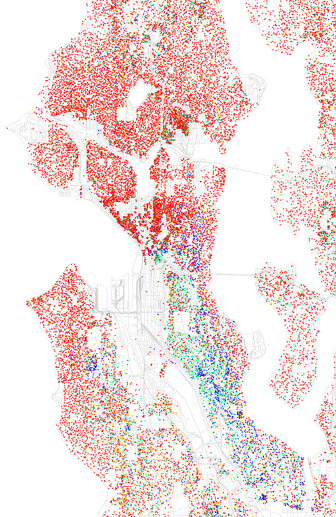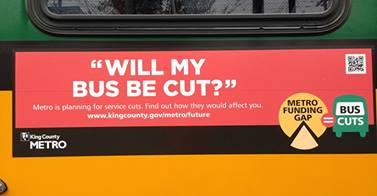They’re out! The cool kids over at Walk Score just posted their all-new 2014 Transit Score rankings with data on transit service in more than 200 cities across the US. And in good news for the Northwest, Seattle’s Transit Score ranks 7th among all large cities, trailing only New York, San Francisco, Boston, DC, Philly, and Chicago. Portland, meanwhile, ranks 10th. (Note that Transit Scores only rank transit within city limits, and don’t cover suburbs or surrounding municipalities, and that I’m counting cities with at least half a million residents as “large.”)
There’s good news beyond the Northwest, too: on average, Transit Scores have inched up a bit since 2012—suggesting that more people are living closer to frequent transit service.
The bad news, though, is that both Seattle and Portland saw their Transit Scores fall over the last two years.
I was lucky enough to get an early peek at the raw data, which provided a fairly fine-grained look at the trends. As it turns out, Portland’s drop was so small that it probably doesn’t mean much. But Seattle’s Transit Score fell by more than a full point (technically, 1.3 points, but it winds up looking like 2 points because of rounding). That’s one of the largest drops among the 80 cities that had Transit Score rankings in both 2012 and 2014.
So what gives? Why did Seattle’s Transit Score dip?
The Transit Score methodology can seem a little confusing. But basically, adding transit routes or increasing the frequency of nearby transit service boosts a location’s Transit Score, while eliminating routes or reducing service frequency lowers the score. Rail, cable cars, and ferries count more than buses towards a location’s Transit Score. To score a whole city, the Transit Scores of individual locations throughout the city are weighted by population, then averaged.
With all that in mind, and looking at the neighborhood-level changes in Transit Scores, there’s one likely explanation for Seattle’s dip. In late 2012, King County Metro made some significant changes to Seattle bus service—closing and consolidating some bus routes, while boosting service on the new “RapidRide” C and D lines. And on net, the reshuffling of neighborhood transit service reduced the city’s overall Transit Score.
Some parts of the city clearly benefited from the changes. For example, the Fauntleroy, Roxhill, and East Delridge neighborhoods in West Seattle are all on the route of the new C line, and all saw a nice bump in their Transit Scores since early 2012. Just so, Interbay, East Ballard, and Broadview all saw a Transit Score boost from the D line.

But at the same time, neighborhoods like Mt. Baker, Columbia City, Beacon Hill, Brighton, and Holly Park had particularly steep declines in Transit Scores. That’s where Metro eliminted of “duplicative” routes along the Central Link light rail lines in late 2012. And, as shown by Eric Fischer’s nifty map to the right, that same corridor also happens to contain the city’s most racially and economically diverse neighborhoods—suggesting that the bus service changes had a disproportionate impact on the lower income, racially mixed neighborhoods in Southeast Seattle.
It’s possible that light rail previously had given Southeast Seattle a nice Transit Score boost. Still, it’s clear that the 2012 bus changes reversed a good share of any gains from light rail.
Just to be clear, I’m not trying to critique Metro here. As far as I can tell, they’re doing their best to provide efficient, frequent service throughout an entire county, not just Seattle proper. And besides, it’s not clear how Transit Score stacks up to actual transit ridership. Indeed, even as Seattle’s Transit Score fell, total transit Ridership on both Central Link light rail and King County Metro bus service rose.
Still, the Transit Score trends for Seattle neighborhoods may reveal a powerful lesson: don’t underestimate the impact of bus service. Even as the city’s rail system expands, buses will remain the mainstay of Seattle’s transit system for the foreseeable future. That means that big changes to bus service can have big impacts on overall transit accessibility—and that even in a light rail corridor, transit-dependent communities can face a big hit when their bus service is trimmed.


Comments are closed.